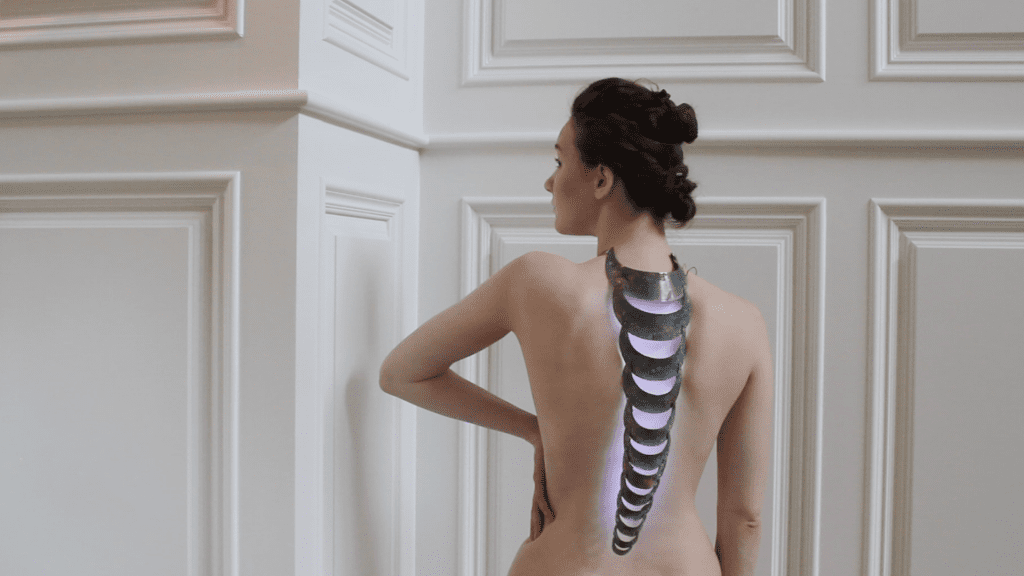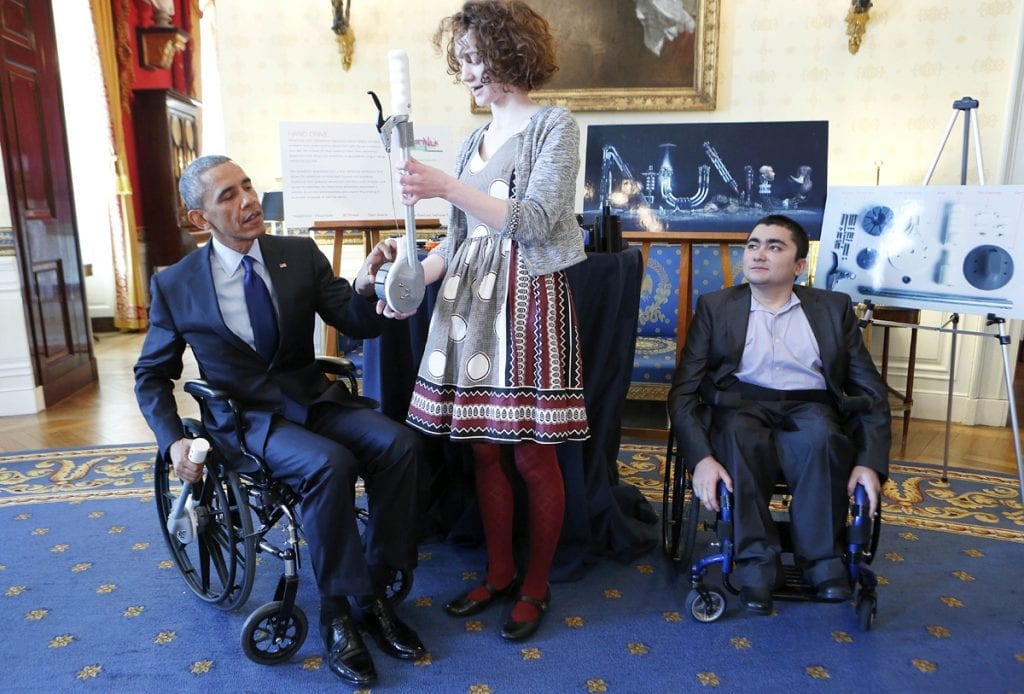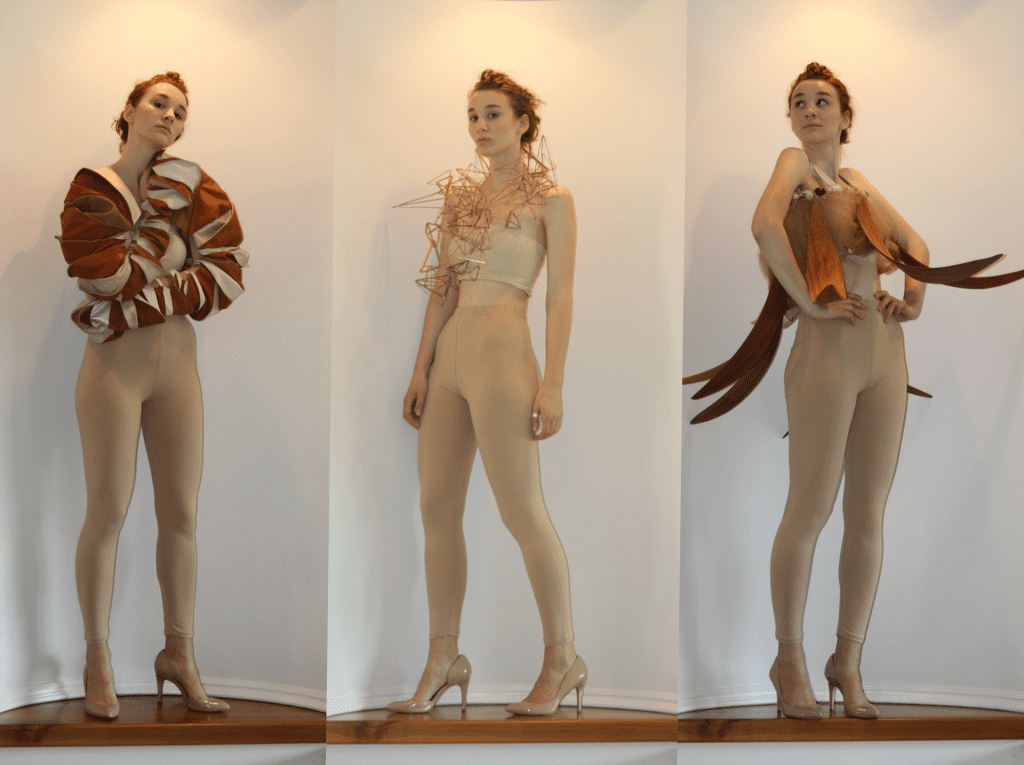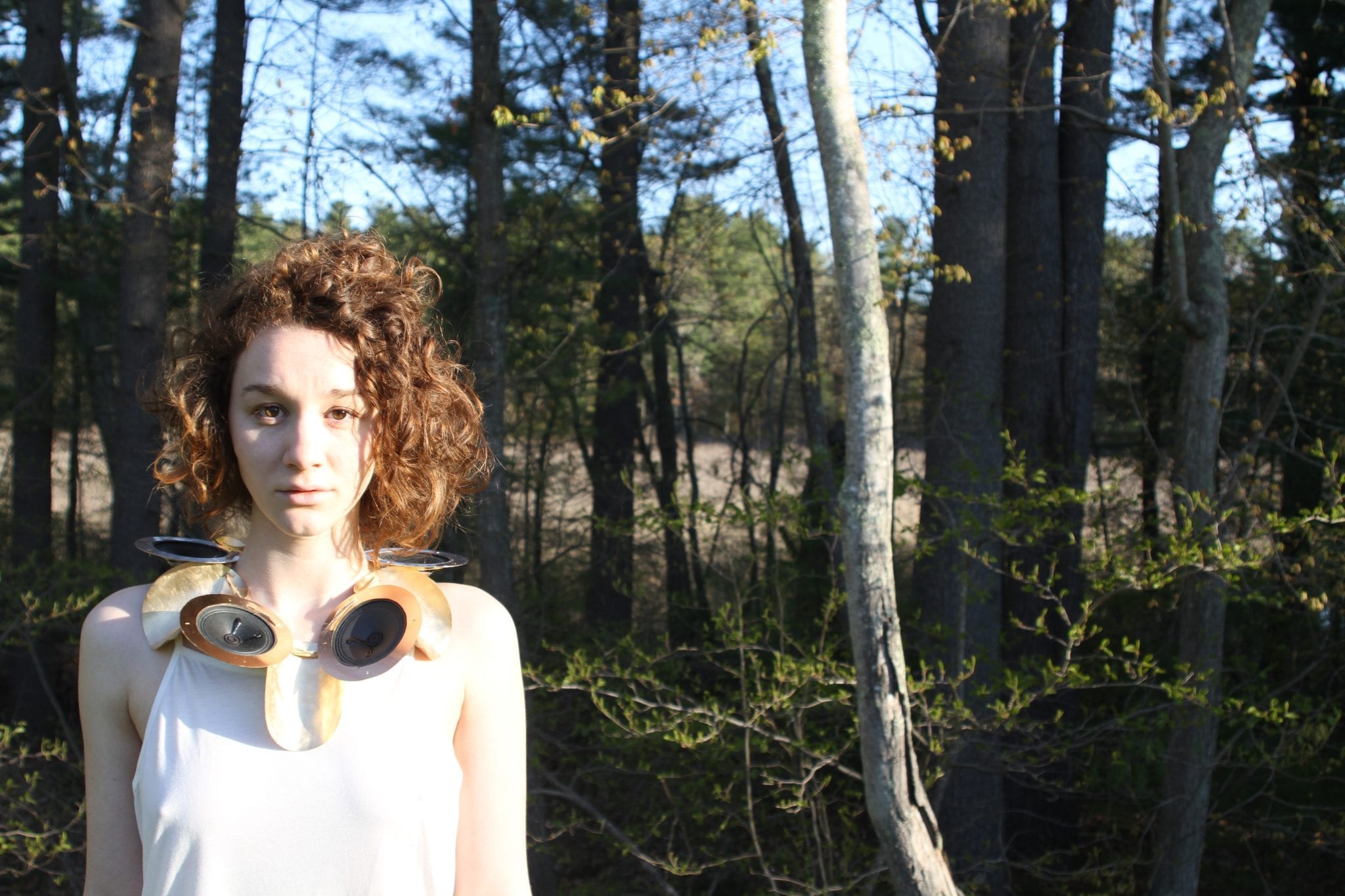She’s met President Obama and been featured in WIRED magazine, but who is Kate Reed and how does her work fuse man, machine and nature?
As we all know, technology influences our behaviour and actions nearly every second of the day. Many believe that because of Moore’s law, computers will be more intelligent than humans within the next few years. One traditional measure of this “intelligence” has been the Turing test, which is a test of a machine’s ability to exhibit intelligent behaviour equivalent to or indistinguishable from that of a human. But theorists such as the University of Oxford mathematics professor Marcus du Sautoy go further in questioning how long it will take for machines to become more imaginative than humans. In his book, The Creativity Code: How AI is Learning to Write, Paint and Think (4th Estate, 2019), Sautoy suggests “for a machine to be deemed truly creative requires one extra step: its contribution should be more than an expression of the coder’s creativity or that of the person who built the data set”. But while Sautoy paints a generally positive picture of the inevitable development of such technology, for 22-year-old designer and artist Kate Reed, there is a more proactive role man must play: “We need to either merge with computers, compete with computers, or risk the end of civilization as we know it.”
The merging of man and machine is already well underway. “Several decades ago, we began to merge humans and computers through external devices, like laptops and smartphones. Decades into the future, we may choose to implant computers into our brains to achieve symbiosis. Today, we merge humans and computers by using wearable technology,” said Kate. “But we are merging wrong. Throughout human history, we have evolved by looking to nature for solutions to our human problems. When conquering flight, humans took the hint from birds. The first submarines were designed in the shape of whales. However, a shift occurred with the development of science fiction. For the past 100 years, humans have looked to science fiction for inspiration when building computers or advanced technologies. Today’s wearable computers, to compete with the exponential threat of digital intelligence of tomorrow, look like gadgets imagined in a Star Trek movie or an Arthur C. Clark novel. They look like computers, feel like computers, and act like computers. This is an unprecedented convergence crisis. Our human body has evolved for millions of years rooted in nature, while computers have evolved for a mere few hundred years, rooted in sci-fi. If humans and computers must converge to combat the rising threat of digital intelligence, we must look to nature for inspiration to build the next generation of wearable computers. And that’s what I’m working on.”
Pioneering a new field in biomimetic wearable technology has not been without challenges; Kate started building wearable computers before the Apple Watch came out, so people were just calling these devices wearables. But this label never felt right to her, as her creations were less computational and more natural. “Throughout my career, I have swam upstream. The main challenge I’ve encountered was that I was being told my work didn’t quite fit in. My work didn’t fit into a category,” said Kate. “I was building towards this for years, but because my colleagues and professors didn’t know how to describe it, I felt a bit lost. But I had a vision and stuck by it. This was a big challenge. But I found that if you feel that something is right, and you have a vision, keep pushing forward, even if it’s hard to articulate, eventually it’ll all click.”
Kate is currently working in partnership with Hyundai to build bioacoustic wearable computers. She is working on a prototype which explores ways to mask the human audio trace through a wearable device that can sample its surroundings and play the sounds back in real-time, adding sound to cancel out the sonic footprint of the user, effectively creating a sonic invisibility cloak.
Nature’s impact on Kate’s work is clear; this latest project takes its cues from animal camouflage in its attempts to create privacy for the user.

Her 2019 work ‘Parasite’ also takes inspiration from the natural world, and is a commentary on our increasing parallel existence with cyborgs. In Kate’s eyes, technology has been a parasite for many years, feeding off of human actions and emotions, instigating behaviour both provoking and addicting, and this piece exaggerates the parasitic aspects of technology by making them visible.
While these two works take their cues from the animal kingdom, it is important to Kate that she keeps the human element at the epicentre of each piece of work, an instinct that was first cultivated as part of her unconventional education pathway. Hailing from Dover, Massachusetts, Kate was raised near the Massachusetts Institute of Technology (MIT) campus and grew up in a high-achieving family. Her mother, Susan Reed, is a world-renowned musician, storyteller and artist, whilst her dad, Kenneth Reed, is a doctor and medical entrepreneur. Kate said: “Growing up, I was nurtured with a rare duality oscillating between entrepreneurship and artistry. I had the best education on the planet. My mom homeschooled my sister, my brother and I throughout our elementary school years. She made the world our classroom — we travelled to Greece to study Ancient History and to Italy to learn about the Renaissance. I didn’t read textbooks, I lived them.”
Although Kate tried attending public high school for two weeks, she didn’t fit in there. She dropped out to become the first full-time student at NuVu Studio, an MIT-backed, personalized, project-based education, used to replace the traditional high school experience. Kate said: “I spent my day at NuVu and took college requirements at community colleges around the edges. At NuVu, my learning environment was filled with world-class technology — technology that most adults only dream of. All the MIT Media Lab’s resources were at my fingertips.”
At NuVu, Kate and her classmates completed project challenges every two weeks, working through the design process, prototyping, building, documenting, then formally presenting each project to the community. Kate said: “Understanding the creative, and making, process, and having software tools at my command gave me the confidence and power to create the things I imagined. Once I realized that I had the ability to make products, and the ability to create experiences for people, I started to understand the power of design. When I realized that I could create things to solve problems and help people, I was hooked.”

Real-world projects the NuVu students tackled included lowering the water temperature in the Gulf of Mexico, hacking a wheelchair and making it better, and creating educational animations. Kate even got to present their Hand Drive wheelchair to President Obama for the White House Science Fair. Kate said: “When the White House called, we were still in the prototype process for the Hand Drive. We quickly jumped into action and had a very busy two weeks leading up to the White House. The actual day of the Science Fair was a blur. I spent the day presenting the Hand Drive to famous actors, scientists, and senators. It wasn’t until twenty minutes before that I found out I would be one of the few presenting to President Obama. First, forty people with cameras came into the room and filled the space, and then, in came President Obama. Strangely, I wasn’t flustered when he arrived. We exchanged friendly banter, then I showed him how the Hand Drive worked. He gave it a try and promptly broke it. Yes, President Obama actually broke the Hand Drive in front of every major news station in America. He tried to use it when the brake was still on and snapped the ratchet – what a powerful man!”
The group’s Hand Drive device was covered by WIRED, selected as a Hackaday Prize Best Product Finalist, and it was in the 3D Printing the Future Exhibit at the Museum of Design of Atlanta. Even now, five years later Kate still gets emails every month about the product. While Kate’s work has become more nature-oriented over time, this early project was an articulation of one of Kate’s major motivations; providing an inexpensive solution to an unmet need. Kate said: “I am a firm believer in using design to eradicate social problems. As designers, we have the tools to truly change the world. I practice responsible design, focusing on the logistics and ethics of creating a design that empowers the people it serves. This concept pushes me to understand what I am designing when, why I am designing it, while continually clarifying for myself who is benefiting. We have a human flaw. We are often unwilling to care, educate, train, and empower those with less than us. We are hopelessly competitive and driven by power. Even when we help those with less than us, we do it for egotistical reasons. As designers, we can right the wrongs of those who came before us and design responsibly, towards progress for all. Today, my focus is on merging man with machine in a humane way, in a way that feels like humans are growing and evolving, versus feeling like we are hijacked by technology. The challenge of this century will be to create symbiosis between the natural world and our technological world.”
You don’t need to be a genius to see that this is a topic Kate is extremely passionate about; she even gave a talk at the 2016 Hackaday Super Conference titled: “Designing for Humans, Don’t Forget the People”. Kate said: “Humans are living breathing spiritual creatures who are far more intuitive and emotional than we acknowledge. When creating something new, like with my biomimetic wearable computers, it’s easy to get swept up in the thrill of technology and mechanics, to rush and say, ‘It works!” But I always remind myself, don’t forget the people. As designers and makers, we must invent for the deeply complex creatures that we are, constantly asking ourselves if we are improving the human experience in all that we make.”
Kate is currently a student on the Brown/RISD Dual Degree Program, a course she chose for its ability to synthesise her interests in technology, art and nature. Kate said: “At NuVu, I had cycled through the creative process again and again. I had built over a hundred computers at NuVu designed to imitate the models, systems, and elements of nature. By the time I left NuVu, a thesis was forming in my mind that in order to merge humans and computers, we must imitate patterns and strategies found in nature. I began to design wearable computers that look and feel like an extension of the human body, inspired by the beauty of nature that I grew up with. These wearable computers monitor, augment, and amplify the human emotional experience. To build these wearable computers I needed an interdisciplinary approach to education. I wanted the hands-on design education that I was used to at NuVu, but I also craved the technical skills that I could acquire at Brown. The Brown/RISD Dual Degree program was a good match. As I began the search for my college education, I knew I was looking for a creative environment and a combination of academic and skill-based learning. Not an easy find. Today, I am studying Social Innovation and Entrepreneurship at Brown University, and Industrial Design and Computational Technology at RISD. I’ve completed 50 courses in under four years, and still have one more year to go.”
“In college, I realized that the biggest problems in the world that need fixing must be solved through design. As designers, we have the power and capability to fix those problems, for good. We are the generation of action, and the time is now. One of the largest problems that humans face is merging man and machine in a healthy way. And my aim is to solve this using the principles and systems of nature,” said Kate. Focusing on the humans at the core of her designs means Kate is always thinking about the inequalities that permeate society and thinking of innovative ways to combat these in her work. She said: “We all struggle out of fear of our differences, and ignoring our social injustices comes too easily to us. Only in acknowledging our fears in an intimate and safe way can we begin to move towards collective social change. I try to make all my projects accessible to all, without barriers of age, ability, or finance.”
Motivated by this interest in people and a desire to make us more connected to each other and the world around us, Kate said: “We are in a social emergency. As a world culture, we are suffering from a lack of engagement with our natural world. This has led some towards apathy, and others towards feelings of helplessness, due to a lack of understanding of our connection to each other, the larger planet, and the larger whole. Our climate is changing. Without intervention and responsible choices, this will eventually lead to our planet becoming inhabitable to humans. With the rise in technology, our human species is simultaneously experiencing a shift in the concept of community. We are increasingly surrounded by people who share our same views and opinions. We are grouped on social media by our likes, creating homogenous societies, which lack diversity of thought and action. Our social interactions are becoming more and more superficial every day. Yet, at our core, we are social beings and crave meaningful interactions with others. Both imbalances are man-made. Through our own self-absorption, we’ve harmed not only our social world but our natural world too. Through awareness, we can make better choices for our planet and our relationships, and harness the power of collective action. Design can empower communities. Responsible design can eradicate social problems. Right now, I am focused on the merging of human and machine, and perfecting that connect early, before it is too late.”

One of Kate’s earlier attempts to forge meaningful interactions between people was with her Musical Prosthetics project, created in 2018 while she was a Social Innovation Fellow through Brown’s Swearer Center. These musical prosthetics are a new form of interactive media and performance art for enhancing non-verbal communication. They are wearable sculptures that are attached to the human body in various exoskeletal formations. Wired with sensors, they create sounds triggered by body movement.
Each wearable sculpture explores a different human emotion. As performers interact with each other, their music creates a window into the often implicit non-verbal world. Three Musical Prosthetics express the primary colours of human emotion: worry, anger, and happiness. The worry prosthetic is made from sewn leather and slumps over the shoulders, turning inward. The anger prosthetic is made from bronze prisms protruding outward in sharp, edgy points. The happiness prosthetic has sculpted wood petals that are light, joyous, and playful. Kate said: “We have never been in a world so digitally connected, or in a world so personally disconnected in many ways. Technology makes it increasingly difficult for us to have face to face time with others. Buried in cell phones and social media, we may risk not noticing, or seeking to understand, those around us, and our communication skills and awareness may suffer. Musical Prosthetics attempts to build bridges from one person to another through the performance of feeling. Musical Prosthetics brings the human back into technology and uses that technology as a tool for understanding emotion rather than hiding it. Through sight and sound, Musical Prosthetics dramatizes a simulation of our everyday emotional lives, showing our emotions rather than telling about them.”
This project is rooted within a deep tradition of performance art and fashion. The pieces fit aesthetically into the tradition shaped by Iris Van Herpens’s designs, building upon the tradition, materials, and processes of making wearables. Musical Prosthetics helps extend trends within the fashion world, as shown by designers like Jean Paul Gaultier, who use fashion as a discourse for expressing identity, whether in terms of emotion, gender, or other kinds of expression. In a 2015 TEDTalk, performance artist Marina Abramovic said: “We are afraid of suffering, we are afraid of pain, we are afraid of mortality, So what I’m doing, I’m staging these kinds of fears in front of an audience – … And then I liberate myself from these fears, and I’m your mirror, if I can do for myself than you can do for you.”
Kate’s Musical Prosthetics work within this tradition by using wearable sculpture to exaggerate the ways in which people communicate, proving through performance art, costume, music, and movement that emotional connection and communication is still possible in this increasingly technological age. Kate said: “At the end of the day, it’s not my work. It’s the work of nature. Nature that has existed for billions of years. I am merely listening to nature closely, in search for the answers to the biggest problems of our generation. I encourage others to do the same in hopes to make the world a more equitable and loving place.”
After graduating, Kate plans to start a company to pursue her vision of merging technology and humans in a way that won’t bring about the end of civilisation as we know it. One way in which Kate plans to get this business off the ground is with the support of the mentors she has met through the Slavin Family Foundation Fellowship. Kate has benefitted from being linked to an international community of young, like-minded people who want and believe they can change the world for the better. Kate said: “As the first designer in the Fellowship, operating at the intersection of social change and design, I fit right in. The Fellowship provides access to mentors in all fields, especially in business. So far, these mentors have been very helpful in understanding the mechanics of fundraising and the logistics of starting a business. Their message has been – go for it! I truly believe the people in the Slavin Fellowship will change the world.”
And you know what? Listening to Kate, we think she might just be capable of it.
Find out more about Kate’s work here and follow her on Instagram @orangebark.
Words by Beth Kirkbride
@BettyKirkers
